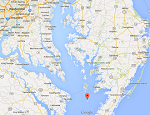British Vice Admiral Alexander Cochrane’s April 1814 Proclamation made a promise that the British would welcome those who departed the United States. Aimed at enslaved African-Americans, Cochrane had a thousand copies distributed in the Chesapeake region. Runaway slaves could negotiate for their freedom by joining the British military, or by relocating as a free people to a British colony.
“That all those who may be disposed to emigrate from the United States will, with their Families, be received on board of His Majesty’s Ships or Vessels of War, or at the Military Posts that may be established upon or near the coast of the United Sta -Vice Admiral Alexander Cochrane

Google Maps.
For some enslaved African-Americans, the War of 1812 offered a rare chance to escape bondage. The outbreak of fighting presented two conflicting paths to freedom: fighting for the United States, or joining with British forces as Loyalists. The starkly divergent nature of the two paths forced enslaved African-Americans to make difficult, pragmatic decisions in choosing sides.
Geography often played a role in those decisions. Particularly in the Chesapeake Bay region, some African-Americans chose loyalism, convinced that a British victory would bring about not only their own freedom but an end to slavery.
As British ships began to enter Chesapeake Bay in March 1813, some enslaved African-Americans made their way in small boats to claim their freedom. In April 1814, after Vice Admiral Alexander Cochrane became Commander-in-Chief of British forces in the North Atlantic, he issued a proclamation aimed at African-Americans still in bondage. Addressed “to all persons wishing to emigrate from the United States,” Cochrane’s proclamation noted that those escapees would be received by the British, as “either entering into His Majesty’s Sea of Land Forces,” or “as FREE Settlers to the British Possessions in North America or the West Indies.”
Cochrane also ordered the recruitment of a body of Colonial Marines. These all-black fighting units performed with distinction, participating in the battles of Baltimore, Bladensburg, the burning of Washington, and in a number of coastal raids. Cochrane later commented that the “Colonial Marines showed extraordinary steadiness and good conduct when in action with the Enemy.”
To handle the growing exodus of enslaved workers, British forces converted Tangier Island, centrally located at the southern end of Chesapeake Bay, into a military training base named Fort Albion. The base also served as a collection point for enslaved African-Americans before they were transferred to British colonies.
Eventually over 4,000 enslaved African-Americans negotiated for their freedom by escaping to the British. They constituted the largest emancipation of enslaved laborers prior to the American Civil War. About 2,600 black Loyalists settled in Nova Scotia and New Brunswick, while others settled in Trinidad.
The British decision to expand the scope of war by allowing runaway African-Americans to join the crown was complicated, and not entirely altruistic. British officials understood that an exodus of enslaved workers would partially undermine the social order in the American South, and might bolster the crown’s military efforts there. But British officials were also wary of too-extreme measures: an insurrection among enslaved workers in America, for example, could easily spread to enslaved workers in British holdings in the Caribbean. Those trepidations explain why the British Secretary of State for War and Colonies ordered military leaders not “to give encouragement” to American “Negroes to rise against their masters.”
Last updated: August 15, 2017
